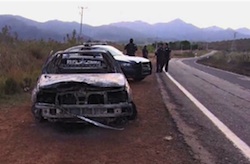Mexico’s Jalisco Cartel has reportedly killed 15 police officers in the Pacific state of Jalisco, a brazen act of violence that will most likely draw the wrath of security forces and may stem the criminal organization’s rapid expansion.
On April 7, Mexican authorities confirmed that the Jalisco Cartel – New Generation (CJNG, for its Spanish initials) ambushed a police convoy and killed 15 police officers in the state of Jalisco, reported the BBC. Five additional police agents were reportedly injured in the attack, which took place on April 6.
It appears that the attack on police — the deadliest since President Enrique Peña Nieto took office in December 2012 — is the latest installment in an escalating conflict between security forces and the CJNG.
During a press conference, Jalisco’s security commissioner, Alejandro Solorio Arechiga, said the ambush was in response to the death of Heriberto Acevedo Cardenas, alias “El Gringo,” who was killed during a confrontation with security personnel on March 23, reported Informador. El Gringo allegedly commanded a CJNG cell that operated in the town of Zacoalco de Torres and three other municipalities.
The security commissioner drew similar conclusions for the motive behind the April 6 murder of the police director in Zacoalco de Torres, as well as the March 30 attack the commissioner himself suffered at the hands of the CJNG.
On March 19, members of the CJNG toting assault rifles and grenade launchers murdered five police officers in the town of Ocotlan, reported El Universal. Two civilians and three suspected criminals were also reportedly killed. In total, authorities have attributed the deaths of 21 police officers in just 20 days to the CJNG.
On April 8, two days after the most recent deadly attack, the US Treasury Department designated the CJNG and the cartel’s top commander, Nemesio Oseguera Cervantes, alias “El Mencho,” to its drug “kingpin” list.
InSight Crime Analysis
The high police body count has grabbed international headlines, and will likely bring an unprecedented level of attention from Mexican and US authorities to the CJNG. Prior to the March 19 attack, authorities in Jalisco were unaware of the level of firepower and sophistication the CJNG possess, according to El Universal. This elevated profile is unlikely to bode well for the cartel, considering that the Mexican government has proved efficient at targeting the leadership of criminal groups that commit sensational acts of violence.
In 2011, Mexican troops poured into the northeastern town of San Fernando, near the US-Mexico border, after reports emerged that the Zetas were using sledgehammers to kill innocent bystanders. Just eight months before, in the same area, the Zetas had massacred 72 migrants. By the end of 2012, many of the group’s top leaders had been either captured or killed. More recently, in October 2014, Mexican authorities captured one of the top leaders of the criminal group Guerreros Unidos less than one month after the gang allegedly murdered over 40 students, a case that rocked Mexico and gained international notoriety.
SEE ALSO: Mexico News and Profiles
Given this track record, El Mencho’s days as a fugitive may be numbered. It is possible that this bloody attack will mark the peak of the CJNG’s power and influence, before security forces train their focus on the cartel. However, the CJNG’s continued expansion despite the arrest of a number of leaders — including El Mencho’s son and second-in-command in January 2014 — suggests the cartel may yet avoid the fate of the Zetas and other beheaded criminal groups.
Indeed, since its formation in 2010, the CJNG has been characterized by its ability to adapt to adversity. The cartel emerged following the killing of the Sinaloa Cartel’s Jalisco boss, Ignacio “Nacho” Coronel, who gave orders to the Milenio Cartel, the predecessor to the CJNG. Coronel’s death helped spur a split within the Milenio Cartel, and the two warring factions fought for control of drug trafficking routes in Jalisco.
SEE ALSO: Coverage of the Jalisco Cartel
The CJNG (known as “Los Torcidos” at the time) eventually won, and it has since established a presence in a total of eight states plus the Federal District (Mexico City), according to Mexico’s Attorney General’s Office. This includes neighboring Michoacan, where the CJNG is looking to take control now that the Knights Templar have been decimated. The fragmentation of Mexican cartels in recent years appears to be enabling the CJNG to gain a stronger foothold in other parts of the country as well.
The CJNG is “the fastest expanding cartel” and could “in the near future overtake the Sinaloa cartel as the most significant organized group in Mexico,” Mike Vigil, the former head of international operations for the US Drug Enforcement Administration (DEA), recently told Global Post.
In many ways, Jalisco state is a strategic base of operations for organized crime groups. It has not attracted the same level of federal attention in recent years as embattled states like Michoacan, but has a history of powerful drug trafficking organizations, including the Guadalajara Cartel and the Sinaloa Cartel. This means the infrastructure for criminal economies in Jalisco is already in place, which the CJNG is able to use to its benefit.
Nevertheless, the recent attack on police — and the furor it provoked — could put the CJNG’s future in serious jeopardy.

